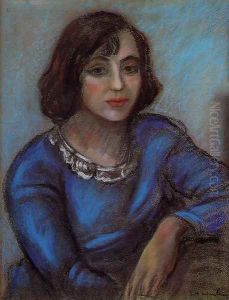Theophile-Alexandre Steinlin Paintings
Théophile-Alexandre Steinlen was a Swiss-born French Art Nouveau painter and printmaker. Born in Lausanne, Switzerland, on November 10, 1859, Steinlen studied at the University of Lausanne before moving to Paris in 1881 to work as a designer and cartoonist. It was in Paris that Steinlen's artistic career would truly flourish.
In Paris, Steinlen became immersed in the bohemian community of Montmartre, the hub of avant-garde art and culture at the time. He was closely associated with the literary and artistic circles of the city, frequenting the famed cabaret Le Chat Noir, which would later become a central subject of his works. There, he rubbed shoulders with the likes of Henri de Toulouse-Lautrec, Adolphe Willette, and Aristide Bruant, who influenced his work significantly.
Steinlen is best known for his depictions of the lives of the working class and the underprivileged of Paris, often imbued with a strong sense of empathy and social commentary. His most renowned work is the poster 'Le Chat Noir' (1896), which advertised the cabaret of the same name and has become an iconic image of the period. Cats became a recurring theme in his work, symbolizing both the bohemian lifestyle of Montmartre and the independent spirit of the Parisian working class.
Steinlen's contributions to the arts extend beyond painting and printmaking. He also produced illustrations for advertisements, book covers, and contributed numerous drawings to French magazines like 'Gil Blas' and 'Le Rire', through which he commented on social issues of his time. His illustrations often mirrored his political interests, showing a sympathy for socialist causes.
Steinlen passed away on December 13, 1923, in Paris. Although he is less well-known than some of his contemporaries, his work has had a lasting influence on graphic art and poster design, and his compassionate portrayal of ordinary Parisians offers a vivid snapshot of life during the Belle Époque.
